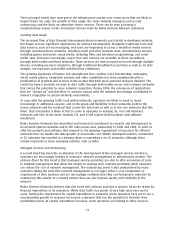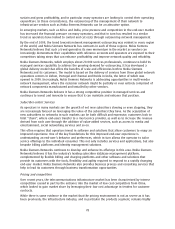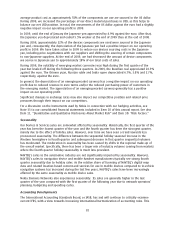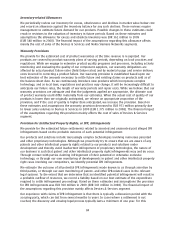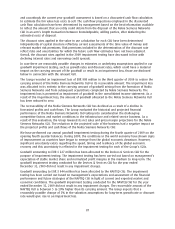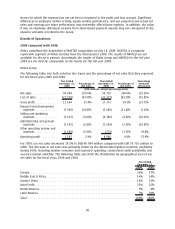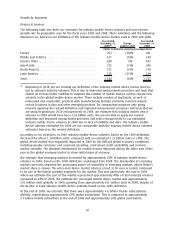Nokia 2009 Annual Report Download - page 88
Download and view the complete annual report
Please find page 88 of the 2009 Nokia annual report below. You can navigate through the pages in the report by either clicking on the pages listed below, or by using the keyword search tool below to find specific information within the annual report.rates to be used based on the risk inherent in the related activity’s current business model and
industry comparisons. Terminal values are based on the expected life of products and forecasted life
cycle and forecasted cash flows over that period. Although we believe that the assumptions applied in
the determination are reasonable based on information available at the date of acquisition, actual
results may differ from the forecasted amounts and the difference could be material.
Valuation of Longlived and Intangible Assets and Goodwill
We assess the carrying amount of identifiable intangible assets, longlived assets if events or changes
in circumstances indicate that such carrying amount may not be recoverable. We assess the carrying
amount of our goodwill at least annually, or more frequently based on these same indicators. Factors
we consider important, which could trigger an impairment review, include the following:
• significant underperformance relative to historical or projected future results;
• significant changes in the manner of our use of these assets or the strategy for our overall
business; and
• significantly negative industry or economic trends.
When we determine that the carrying amount of intangible assets, longlived assets or goodwill may
not be recoverable based upon the existence of one or more of the above indicators of impairment,
we measure any impairment based on discounted projected cash flows.
This review is based upon our projections of anticipated discounted future cash flows. The most
significant variables in determining cash flows are discount rates, terminal values, the number of
years on which to base the cash flow projections, as well as the assumptions and estimates used to
determine the cash inflows and outflows. Management determines discount rates to be used based
on the risk inherent in the related activity’s current business model and industry comparisons.
Terminal values are based on the expected life of products and forecasted life cycle and forecasted
cash flows over that period. While we believe that our assumptions are appropriate, such amounts
estimated could differ materially from what will actually occur in the future. In assessing goodwill,
these discounted cash flows are prepared at a cash generating unit level. Amounts estimated could
differ materially from what will actually occur in the future.
Goodwill is allocated to the Group’s cashgenerating units (CGU) and discounted cash flows are
prepared at CGU level for the purpose of impairment testing. The allocation of goodwill to our CGUs is
made in a manner that is consistent with the level at which management monitors operations and
the CGUs expected to benefit from the synergies arising from each of our acquisitions. Accordingly,
(i) goodwill arising from the acquisitions completed by the Devices & Services segment has been
allocated to the Devices & Services CGU, (ii) goodwill arising from the acquisition of and acquisitions
completed by NAVTEQ has been allocated to the NAVTEQ CGU and (iii) goodwill arising from the
formation of and acquisitions completed by Nokia Siemens Networks has been allocated to the Nokia
Siemens Networks CGU.
The recoverable amounts for the Devices & Services CGU and NAVTEQ CGU are determined based on a
value in use calculation. The cash flow projections employed in the value in use calculation are based
on financial plans approved by management. These projections are consistent with external sources
of information, whenever available. Cash flows beyond the explicit forecast period are extrapolated
using an estimated terminal growth rate that does not exceed the longterm average growth rates
for the industry and economies in which the CGU operates.
In prior years we used a value in use calculation to determine the recoverable amount of the Nokia
Siemens Networks CGU. In 2009 the value in use calculation resulted in a recoverable amount that
was lower than the carrying amount for the Nokia Siemens Networks CGU. As a result, we performed
an analysis to determine the fair value less costs to sell of the Nokia Siemens Networks CGU. The fair
value less costs to sell of the Nokia Siemens Networks CGU exceeded its value in use. IFRS requires
that recoverable amount is based on the higher of the value in use and fair value less costs to sell
86



